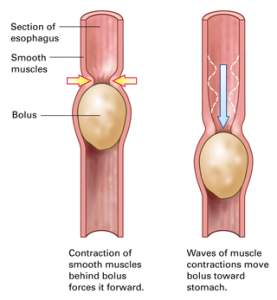

MedFriendly®


Peristalsis
Peristalsis is a series of wavelike, coordinated
contractions and relaxations of a tube-like structure in the
body that forces the contents of the tubes onwards.
Contractions refer to when something, such as muscle, is
reduced in size by being forced or squeezed together.
WHAT ARE SOME EXAMPLES OF PERISTALSIS?
The most common example of peristalsis is when food and
waste products are pushed through the intestine (a tube
shaped structure that is part of the digestive tract).
FEATURED BOOK: The Permanent Pain Cure for Joint Pain
Peristalsis also occurs in the esophagus, which is the natural tube in the body that food
travels down to enter the stomach. In the esophagus, peristalsis is what pushes food
down towards the stomach, even when the body is upside down.
Peristalsis also occurs in the stomach so that it can mix the food together with stomach
juices and move the partially digested food into the first part of the small intestine (known
as the duodenum).
The small intestine is a part of the intestine that takes in all of the nutrients (healthy
substances) that the body needs. In the small intestine, peristalsis becomes a slow back-
and-forth churning movement. This allows more time for nutrients to be absorbed.
"Where Medical Information is Easy to Understand"™
Connecting to the small intestine is the large intestine. As you may
have guessed, peristalsis also occurs in the large intestine. The
large intestine absorbs moisture from the matter that is left after it is
digested in the small intestine and excretes the waste from the anus
(rear end).
Excrete means to release from the body as waste. In the large
intestine, peristalsis occurs once every 30 minutes. A strong,
sustained wave of peristalsis occurs in the colon two or three times
a day (usually after a meal), which forces the waste material into
the last part of the large intestine (the rectum) and prompts the urge
to poop. The colon is the major part of the large intestine.
Another example of peristalsis is when pee is forced through the ureters. The ureters are two tube-shaped
structures that connect to the kidneys and carry urine to the bladder. The kidneys are two organs located
on each side of the spine, behind the stomach. The kidneys filter (remove) wastes from the blood.
Yet another example of peristalsis is when bile is pushed through the bile duct. Bile is a bitter, yellow-
green substance released from the liver that carries away waste products. The bile duct is a tube-shaped
passageway that carries bile. The liver is the largest organ in the body and is responsible for filtering
(removing) harmful chemical substances, producing important chemicals for the body, and other important
functions.
HOW DOES PERISTALSIS WORK?
The walls of many passages in the body contain a special type of muscle known as smooth muscle. The
fibers (long cells that make up muscles) squeeze together in sequence, which sends waves of squeezing
motions along the walls of the passage. Using the intestine as an example, as each group of muscle fibers
squeezes together in the walls of the intestine, the passageway inside the intestine gets smaller. The
effect of the squeezing motion is to push the food onwards to the next section of the intestine where the
muscle wall is relaxed.
To get a better understanding of peristalsis, an analogy would be placing some food, such as applesauce,
at one end of a straw. In this example, the straw is like the digestive tract and the applesauce is like the
food in the digestive tract. If you squeezed the straw together directly before the area where the
applesauce is located, the applesauce would move forward through the straw. In this way, food passes
through the digestive tract. It is important to note that the movement in peristalsis occurs spontaneously,
unconsciously, and involuntarily. Such movement is referred to as motility.
WHAT ELSE IS PERISTALSIS KNOWN AS?
Peristalsis is also known as vermicular movement.
WHAT IS THE ORIGIN OF THE TERM, PERISTALSIS?
Peristalsis comes from the Greek word "peri" meaning "around," and the Greek word "stalsis" meaning
"contraction." Put the two words together and you get "around contraction."















